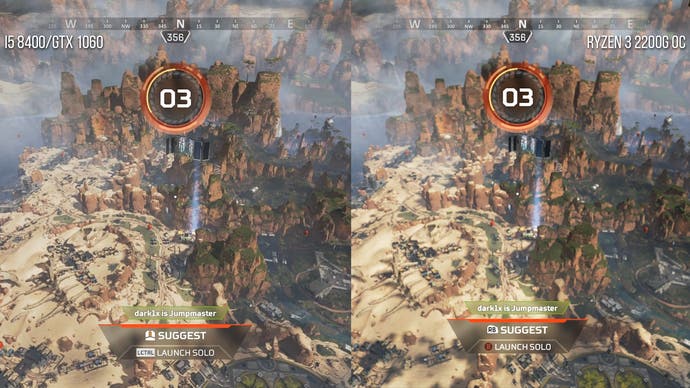Apex Legends: the Titanfall 2 engine evolved?
PC and console versions under the microscope.
Just over 11 years ago, Infinity Ward revolutionised online multiplayer gaming with the release of Call of Duty: Modern Warfare. This past week, Respawn Entertainment, featuring many of the core team responsible for 2007's game-changing title released its take on the battle royale shooter: Apex Legends. Set in the same world as Titanfall 2, it lacks the technological edge that Modern Warfare had in its day, but the quality of the action shines through in ways that its competitors struggle to match.
Commonalities with Titanfall 2 extend beyond the setting - the highly modified Source engine used in Respawn's last title is rolled out once more for Apex Legends, with a number of tweaks - essentially, the inclusion of necessary modifications required in order to deliver a large, expansive map with extensive draw distances. The same visual feature set we saw in Titanfall 2 remains in place then, but Respawn is perhaps a little less extravagant in how it is deployed, presumably in the interests of clarity and readability - essential elements in a multiplayer shooter.
However, the PC version in particular demonstrates how closely Apex Legends is built on Titanfall's tech: system requirements are very similar and the options menu is mostly the same. Curiously though, Apex Legends' tweakables are a sub-set of Titanfall 2's: HBAO+ ambient occlusion is replaced with an SSAO variant, while multi-sampling anti-aliasing (MSAA) is gone. Temporal super-sampling AA was Respawn's 'go to' choice for Titanfall 2 on console, and so it is on PC, where this technology in combination with dynamic resolution scaling is key to getting as close as possible to a 60fps lock. This is Respawn's signature - a dedication to the fastest possible visual feedback and lower input latency. It's all part of getting the 'feel' of the game right. Again, Apex Legends does feel very much like Titanfall 2, and this is no bad thing.
What is evident, however, is that Apex Legends pushes harder and so compromises need to be made. Primarily, this comes down to the dynamic resolution 'window'. Establishing the upper and lower bounds for DRS is challenging, but taking PlayStation 4 Pro as an example, Titanfall 2 seemed to operate mostly in a 1080p to 1440p range. We think that the upper bounds is similar for Apex Legends, but resolution tends spend more time in the 1080p area and we've even seen the 'supercharged PS4' hit 900p too. Xbox One X follows the same principles but offers a step up, spending more time in 1296p territory, while also delivering extended draw distance. As expected, the base consoles take a further hit, to the point where we've even noted resolutions as low as 720p on the PlayStation 4 and 648p on Xbox One.
Suffice to say that the quality of the image depends very much on where your hardware sits on the console power ladder - PlayStation 4 looks OK, Xbox One struggles and the enhanced machines look better, deliver improved shadow cascades and potentially even higher quality textures (though clarity here may well be related more towards the native resolution). Volumetric lighting also seems to be downgraded in head to head shots when comparing base and pro hardware. Owing to the DRS system, the clarity of the image is tied very closely to frame-rate, and while most of Apex Legends plays out locked at 60fps, there can be dips - and these are clearly more keenly felt on the base consoles.
It starts on the initial arrival into the stage on the carrier. Far reaching views of the map impact performance on enhanced machines, and the hit to frame-rate on the vanilla consoles is such that Respawn drops 60fps entirely, with the complete descent locked to 30fps instead, before switching to 60fps as soon as the view weapon appears on-screen and the action kicks off properly. All consoles versions have issues managing GPU bandwidth and it is a touch disappointing to see heavy effects work during combat impacting performance, just when you need it most. Users of the enhanced machines are given a smoother ride and a clear advantage here, while owners of the base consoles see the impact to performance magnified still further.
Overall frame-rates are lower on the standard consoles too. There's more instability in performance even in simple traversal, and especially with extended draw distances. Again, it's the vanilla Xbox One that's most affected - and there's an additional twist too: gameplay is interspersed with occasional frame-time stutter that sees anything up to a 180ms hitch in the action - clearly and obviously noticeable in a title targeting a 16.7ms per-frame refresh.

So what does this all mean for the PC version? In common with the console games, Apex Legends is more demanding than Titanfall 2. Nvidia's flagship RTX 2080 Ti cannot sustain 4K60 at max settings, dropping into the 50s in more demanding areas. A GTX 1060 on similar settings fares worse at 1080p, too. The solution is to engage the adaptive resolution technology, which irons out the kinks. Impact to visual quality isn't really an issue on the 2080 Ti, but drops to resolution on the GTX 1060 are much more obvious. Everything points to Apex Legends being more demanding than you'd expect for the visual return - the Titanfall 2 tech is starting to show its age. And yet, Apex Legends is still scalable across a range of hardware.
When I reviewed AMD's £90/$99 Ryzen 3 2200G, I was amazed to find that I could run Titanfall 2 at a mixture of low, medium and high settings locked at 60fps - all thanks to the dynamic resolution scaling technology. Remarkably, bearing in mind the extra demands of Apex Legends, the same trick is possible - albeit using a 1500MHz GPU overclock (but still using the supplied cooler, I should add). Native resolution needs to be set at 900p, and DRS takes that much, much lower in many cases (astonishingly so on occasion!) but the game plays just as smoothly as it does on PS4 - if not more so.
Also fascinating is that four Ryzen cores are plenty to run Apex Legends at 60fps - utilisation is around 50 per cent across the board. Bearing in mind that the Ryzen 3 2200G has no SMT 'hyper-threading' and that it has to share its memory bandwidth the GPU, that's good going. The key to achieving good scalability on a PC game generally requires efficient CPU utilisation - it means that optimising the experience can be safely accommodated via scaling the graphics side of the equation. Apex Legends delivers here.
Visually, Apex Legends is a triumph of smart art direction over technology. The enhanced Source Engine here does feel pushed to its limits bearing in mind its hardware requirements, but the geometric density of the world, the quality of the artwork (in particular materials) looks great. Respawn has been acquired by Electronic Arts now, of course, so the obvious route forward for the studio would be to embrace Frostbite - and giving one of the most impressive engines of the generation to a team this talented for its future projects is a mouthwatering prospect.










.png?width=291&height=164&fit=crop&quality=80&format=jpg&auto=webp)